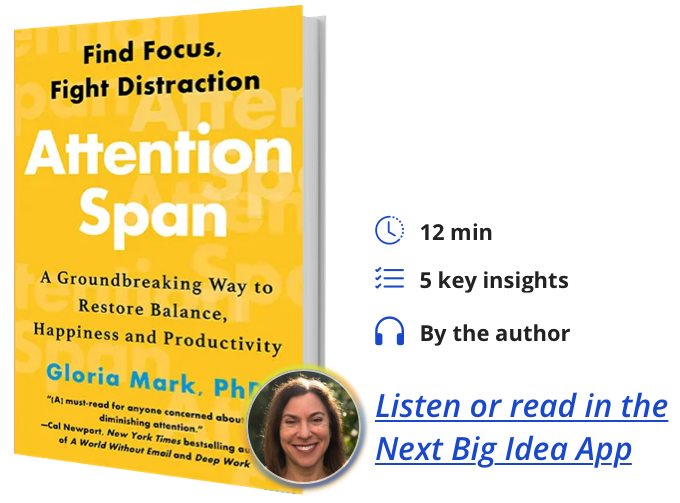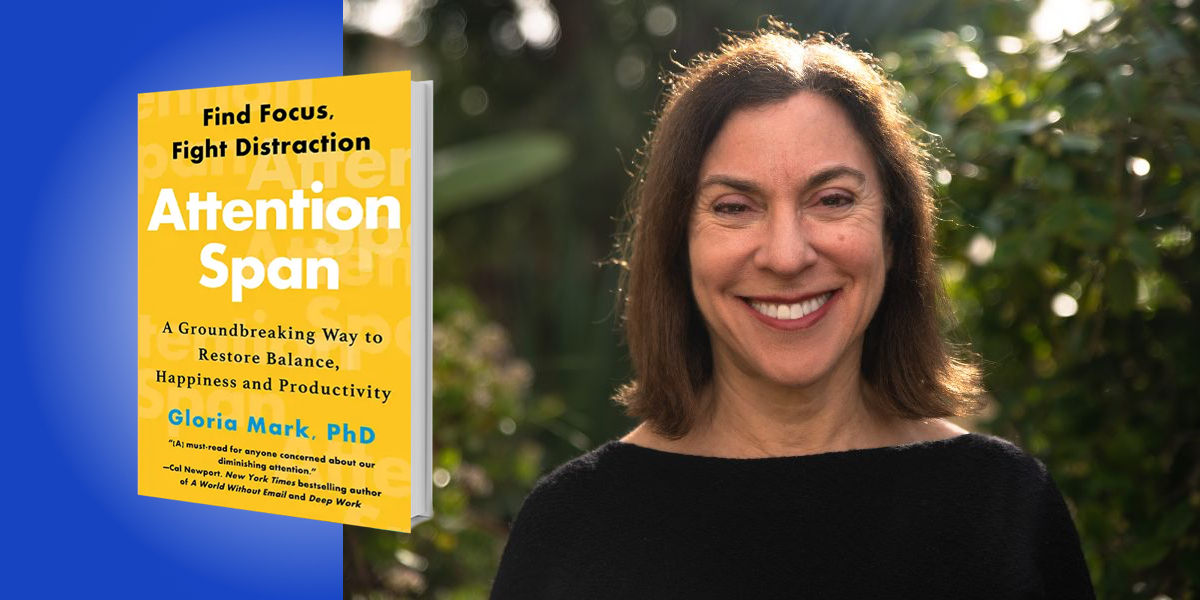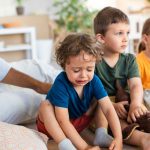Gloria Mark is Chancellor’s professor in the Department of Informatics at the University of California, Irvine. Her new book covers her research from over the last two decades about how our attention and our minds have changed in the digital age.
Below, Gloria shares 5 key insights from her new book, Attention Span: A Groundbreaking Way to Restore Balance, Happiness, and Productivity. Listen to the audio version—read by Gloria herself—in the Next Big Idea App.

1. Use precious attentional resources wisely.
We have limited attentional resources, which you can think of as your attentional capacity. Some things we do replenish our resources, like taking breaks or a good night’s sleep, but when we use our devices it can drain our resources quickly. Our attentional resources are finite and precious.
One way we drain our resources is when we multitask. My research showed that when people are on their computers and phones, they typically switch their attention from app to app, from task to task, from website to website, from screen to screen—and they do so on average about every 47 seconds. This surprised me because it is tiring to switch attention so fast. Yet, the more tired we are the more susceptible we are distraction.
Conserve mental resources for important things by taking breaks and pulling back before exhaustion sets in. The best break of all is going outside for a nature walk. Studies show that even a 20-minute walk in nature can restore attentional capacity, and it helps us generate new ideas.
A good night’s sleep is important too: my research showed that as we accumulate sleep debt over days, we have fewer resources available to self-regulate, become increasingly susceptible to distractions, and we spend more time on lightweight activities, like social media. Consider that you have a limited tank of resources, keep them replenished, and above all, use them wisely.
2. We can leverage different types of attention to our benefit.
The great writer Maya Angelou spoke about her Big Mind and her Little Mind. Her Big Mind was used for deep thought when she wrote. But she would take a pause in her writing to use her Little Mind on simple activities, like crossword puzzles. Big Mind and Little Mind worked together in Angelou’s writing process: Big Mind was used for focused, hard work and Little Mind was used for replenishment so that she could return to work refreshed.
“A lot of great writers and scientists used rote activities like gardening, or simple puzzles, to step back from the hard work of focus.”
Attention is more nuanced than just being focused or unfocused. When you are engaged with something and are challenged by it, then you’re putting in mental effort to focus. But if you’re engaged in a simple activity that is not challenging, like playing crossword puzzles or solitaire, then you’re using what I call rote attention. Using rote attention makes people calm and happy. A lot of great writers and scientists used rote activities like gardening, or simple puzzles, to step back from the hard work of focus. It helped them see their work with fresh eyes.
Just like we have biological rhythms, like our sleep and wake cycle, I also found in my research that there are rhythms over the course of the day for when attention is at a peak. For most people, this happens mid-to-late morning and mid-afternoon. Get to know your personal rhythm and peak focus time. Save your most important tasks that require hard work and creativity for those peak times. When you start feeling your attention wane, do some rote activity, like Maya Angelou did to support her Big Mind.
3. We interrupt ourselves half the time.
Sophisticated algorithms are designed to capture your attention based on your personality or by tapping into most basic emotions, like fear. But we can’t blame interruptions solely on algorithms or other people. We are as likely to interrupt ourselves as to be interrupted by others. A person might be working on a report and then without any external distractor, like a notification, they suddenly stop what they’re doing to check their email.
Interruptions often originate from within ourselves. We are more likely to self-interrupt if the task is too hard, or because we’re bored, have an urge to satisfy some curiosity that came to mind, remember to do something, or simply out of habit.
“Don’t self-interrupt in the middle of a task because then it is extra hard to get back on track when you do.”
Sometimes we self-interrupt because we’re just tired. The more exhausted you are, the harder it is to control inner impulsive urges. Sometimes we need to stop our work to take care of something, but there are better times than others to pause work—such as a natural break point in a task. Don’t self-interrupt in the middle of a task because then it is extra hard to get back on track when you do. Be proactive about self-interrupting at break points, and make the break an opportunity to replenish so that you don’t work until you’re exhausted.
4. You can develop agency to manage your attention.
There are a lot of things we do automatically, like check email, social media, or phone notifications. You can become more intentional in your actions by understanding why you check the news or your socials. Before acting on an urge, pause first to probe the reasons behind it. This can help you become aware of automatic actions and you can assess the value these actions do, or don’t, bring you.
You can also practice forethought, which means considering how your current actions will affect the future—even if that future is as near as later in the day. Before checking the news, imagine what your future self will be doing at 10 p.m. Will you be relaxing reading your favorite book or still working on that deadline?
“Don’t schedule tasks back-to-back; design negative space, time that precedes and follows hard work.”
Another thing you can do is include negative space in your day. The Japanese have an expression, yohaku no bi, which refers to “the beauty of empty space.” If you know the paintings of Joan Miro or the sculptures of Henry Moore, these artists skillfully used the space surrounding objects to enable them to shine. You can use the same idea. Don’t schedule tasks back-to-back; design negative space, time that precedes and follows hard work. Ideally, negative space is used for contemplation which replenishes mental energy. This way, your work can shine.
5. Set a goal to maintain your well-being when you using devices.
The narrative of pushing ourselves to our limits has been in American culture for a long time. For example, BF Skinner, the noted behaviorist psychologist, set his alarm clock to wake himself four times during the night so that he could work.
Our digital devices were invented to extend our human capabilities. We think we’re doing more but we’re paying a price. A growing body of research shows that our use of tech (and especially the pressures associated with it) is linked to stress.
We want to be productive and accomplish great things, but we shouldn’t do this at the expense of increasing stress to levels that affect our health. Remember, our digital age is still young—younger than the fall of the Berlin Wall. Technological innovations happen at rapid-fire speed; meanwhile, we’re racing to learning how to cope with these technologies. The human mind remains a bottleneck for handling all that information. Rather than continuing to push ourselves to our limits, let’s give ourselves permission to pull back. Let’s reframe how we use tech and set a goal of using it to maintain well-being. Productivity will happen along the way.
We are not doomed to have short attention spans. We can change our relationship with technology and make a cultural shift. After all, we created the tech and we also have the power to shape the way we use it.
To listen to the audio version read by author Gloria Mark, download the Next Big Idea App today:
































